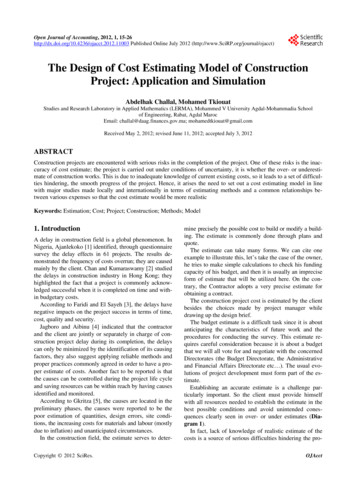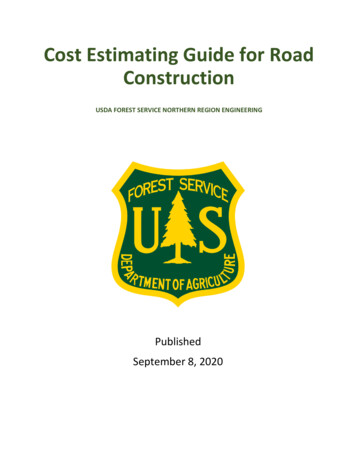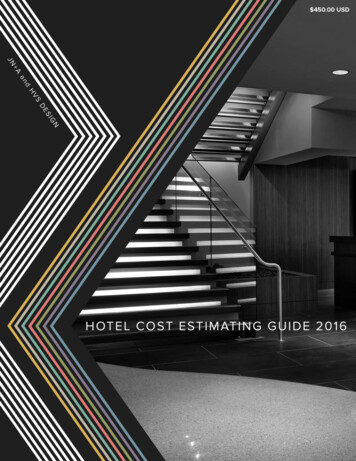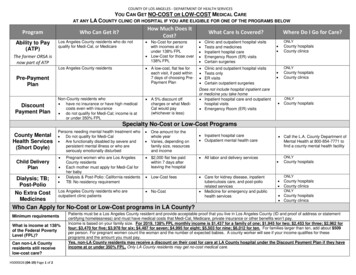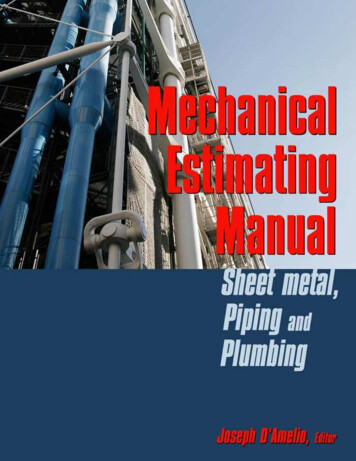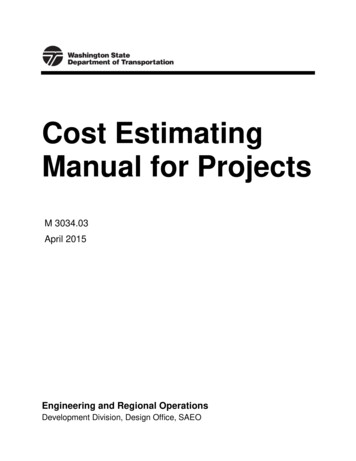
Transcription
Cost EstimatingManual for ProjectsM 3034.03April 2015Engineering and Regional OperationsDevelopment Division, Design Office, SAEO
Americans with Disabilities Act (ADA) InformationMaterials can be provided in alternative formats by calling the ADA Compliance Managerat 360-705-7097. Persons who are deaf or hard of hearing may contact that number viathe Washington Relay Service at 7-1-1.Title VI Notice to PublicIt is Washington State Department of Transportation (WSDOT) policy to ensure no personshall, on the grounds of race, color, national origin, or sex, as provided by Title VI of the CivilRights Act of 1964, be excluded from participation in, be denied the benefits of, or be otherwisediscriminated against under any of its federally funded programs and activities. Any person whobelieves his/her Title VI protection has been violated may file a complaint with WSDOT’s Officeof Equal Opportunity (OEO). For Title VI complaint forms and advice, please contact OEO’s TitleVI Coordinator at 360-705-7082 or 509-324-6018.To get the latest information on individual WSDOT publications, sign up for email updates at: www.wsdot.wa.gov/publications/manuals
ForewordWSDOT’s vision is to be the best at providing a sustainable andintegrated multimodal transportation system. Its mission isto provide and support safe, reliable, and cost-effectivetransportation options to improve livable communities andeconomic vitality for people and businesses.Estimators shouldbe shielded frompressures to keepestimates withindesired amounts.This update to the WSDOT Cost Estimating Guide is part of anongoing process to keep technical information relevant andcurrent, as well as provide consistency with the department’s vision.More of an art than a science, cost estimating requires a thorough understandingof project scope, past price history, and current market conditions, as well as witha generous application of human judgment.Key goals of the estimating process described in this manual include:1. Departmentwide priority on estimating, managing, and controlling costs: Fully developed and integrated policies, processes, and tools for costestimation, management, and control Baseline estimates that align with early project scope developmentand include an initial assessment of uncertainty Clearly defined and documented cost management endorsementprocesses to authorize changes in scope and cost after the baselineestimate is established Dedicated resources that are focused on effective scoping, projectcost estimating, and cost management2. Reliable and accurate estimates: Well-documented and complete cost estimates Clearly spelled-out assumptions, risks, and uncertainties that canbe easily communicated3. Statewide uniformity and consistency: Uniform application and consistent statewide use of well-documentedprocesses, tools, and templates Use of processes and tools during the planning, scoping, design, andletting phasesWSDOT Cost Estimating Manual for Projects M 3034.03April 2015Page i
Foreword4. Improved communication and credibility with external stakeholders: Consistent and clear communication of cost estimates to externalstakeholders at milestone points The ability to communicate cost estimates with confidence, leading tostronger relationships with external stakeholders, greater possibility forcollaboration, and increased funding support of transportation initiatives5. Clear accountability: Accountability for cost estimating and cost management at all levelsof the agency Defined roles and responsibilities for every person involved Accountability that is tracked at key milestones in the processThis manual is intended as a guide for developing and managing project cost. Itprovides policies, rules, procedures, and tools to aid WSDOT staff in preparing projectcost estimates and managing cost throughout WSDOT’s project development process.Although the manual is primarily written for project managers and estimators, it isstrongly recommended that others involved in WSDOT’s project delivery activitiesfamiliarize themselves with this information.The term "project cost estimate," as used during the project development process,includes all direct capital outlay costs, including right of way, structures, andlandscaping, but does not normally include indirect capital outlay support costs.Project cost estimates should be as accurate as possible. Estimates should never beartificially reduced to stay within the funding limits, nor should they be reduced tomake available more funding for region projects. Likewise, project cost estimatesshould not be artificially raised beyond the contingency percentages provided forin this manual unless adequately justified.Cost estimating and cost management tools continue to be developed and will beadded to the department’s estimating tool box as they become available. Please notethat while cost estimating in support of design-bid-build projects is covered in depth inthis manual, there are certain other conditions, such as design-build project delivery,accelerated projects, and accelerated estimates, which are not addressed in detail.Important NoticeThe detailed estimate of any phase of an estimate shall not be disclosed to the publicand will be kept confidential until the end of the bid opening.Page iiWSDOT Cost Estimating Manual for Projects M 3034.03April 2015
DefinitionsA comprehensive glossary for cost risk estimating management is posted at: ry.pdfKey TermsAllowance – Additional resources included in an estimate to cover the cost of knownbut undefined requirements for an activity or work item. Allowance is a base cost item.Base Cost Estimate – The term “base cost estimate” was developed by WSDOT for costrisk analysis and represents the reviewed and/or validated project cost estimate to beused in the quantitative risk analysis for a project. The base cost represents the cost thatcan reasonably be expected if the project materializes as planned, including PE, RW, andCN costs. The base cost estimate is unbiased and neutral—it is not optimistic and it isnot conservative. It does not include any risks, but does include the WSDOT standardconstruction contingency, since that amount is based upon historical usage. Base costsreported to program management shall be in current-year dollars (the un-inflatedestimate). Refer to the Plans Preparation Manual 800.03(2).Baseline – The approved time-phased plan (for a project, a work breakdown structurecomponent, work package, or schedule activity), plus or minus approved project scope,cost, schedule, and technical changes. Generally refers to the current baseline, but mayrefer to the original or some other baseline. Usually used with a modifier (e.g., costbaseline, schedule baseline, performance measurement baseline, technical baseline).Baseline Preliminary Engineering (PE) – The effort (budget/cost) of taking a projectfrom planning through the scoping and design phases of project development. Planningand scoping typically have separate budgets but are encompassed under Design orPreliminary Engineering (PE). The terms “Design” or “Design Phase” are sometimesused interchangeably with PE.Basis of Estimate (BOE) – Documentation to enable the agency to easily track changesto project scope, cost, and schedule. A well-documented estimate basis anddocumentation of assumptions used can eliminate overlap of future estimateassumptions. This document provides a trail about what is known about the project.This allows project “knowns” as well as “unknowns” to be clearly identified. Thisdocumentation is important because multiple estimators may be involved on theproject; complex projects in particular take years to develop and estimates must becompleted multiple times.WSDOT Cost Estimating Manual for Projects M 3034.03April 2015Page iii
DefinitionsConstruction Contingency – A standardized markup applied to the construction cost ofa project that accounts for uncertainties in quantities, unit costs, and minor risk eventsthat typically take place during construction. Refer to the Plans Preparation Manual,Section 800.03, for guidance on estimating construction contingency.Construction Engineering (CE) – The project management effort (budget/cost) appliedto the contract execution and construction phases of the project. Refer to the PlansPreparation Manual, Section 800.03, for guidance on estimating the CE cost.Cost Estimate – A prediction of quantities, cost, and/or price of resources requiredby the scope of an asset investment option, activity, or project. As a prediction, anestimate must address risks and uncertainties. Estimates are used primarily as inputsfor budgeting; cost or value analysis; decision making in business; asset and projectplanning; or for project cost and schedule control processes. Cost estimates aredetermined using experience and calculating and forecasting the future cost ofresources, methods, and management within a scheduled time frame. (Source:Copyright 2007, AACE International, Inc., AACE International RecommendedPractices, Number 10S-90)Estimator – A knowledgeable professional assigned to evaluate the probable cost ofprojects.Parametric Estimate – A method of estimating the cost of a project (or part of a project)based on one or more project-based cost factors. Historical bid data is commonly usedto define parameters related to the cost of a typical transportation facility construction,such as cost per lane mile, cost per interchange or cost per square foot. Percentagescan also be used to estimate the cost of project elements based on historical costinformation. Parametric methods are often used in early estimating, such as planningand scoping estimates. (Source: WSDOT working definition)Risk-Based Estimate – An approach that involves simple or complex risk modeling basedon inferred and probabilistic relationships among cost, schedule, and events related tothe project. Risk-based estimating uses historical data and/or cost-based estimatingtechniques and an expert’s best judgment to develop the project “base cost” (projectcost if the project proceeds as planned). Risk elements (defined as opportunities orthreats) are then defined and applied to the Base Cost through risk modeling to providea probable range for both project cost and schedule. (Source: WSDOT workingdefinition)Risk – The effect of uncertainty on objectives. (Source: ISO 31000, Risk management –Principles and Guidelines)Page ivWSDOT Cost Estimating Manual for Projects M 3034.03April 2015
ContentsForeword. iDefinitions . iiiChapter 1Purpose . 1-1Chapter 2Cost Estimating Process . 2-12-1Introduction . 2-12-2Determine the Basis of Estimate. 2-12-3Prepare a Baseline Estimate . 2-12-4Review the Baseline Estimate . 2-22-5Perform a Risk Assessment . 2-22-6Determine the Estimate Communication Approach. 2-32-7Obtain Management Endorsement . 2-3Chapter 3Cost Estimating Methodology . 3-1Chapter 4Cost Estimating and Project Development Phases . 4-14-1Introduction . 4-14-2Preconstruction General Guidance . 4-14-3Planning. 4-54-4Scoping . 4-74-5Design. 4-104-6PS&E . 4-12Chapter 5Cost Estimate Training . 5-1Chapter 6Documentation/Basis of Estimate . 6-16-1Introduction . 6-16-2Techniques . 6-16-3Basis of Estimate (BOE) . 6-1Chapter 7Cost Estimating Data.
This manual is intended as a guide for developing and managing project cost. It provides policies, rules, procedures , and tools to aid WSDOT staff in preparing project cost estimates and managing cost throughout WSDOT’s project development process. Although the manual is primarily written for project managers and estimators, it is

